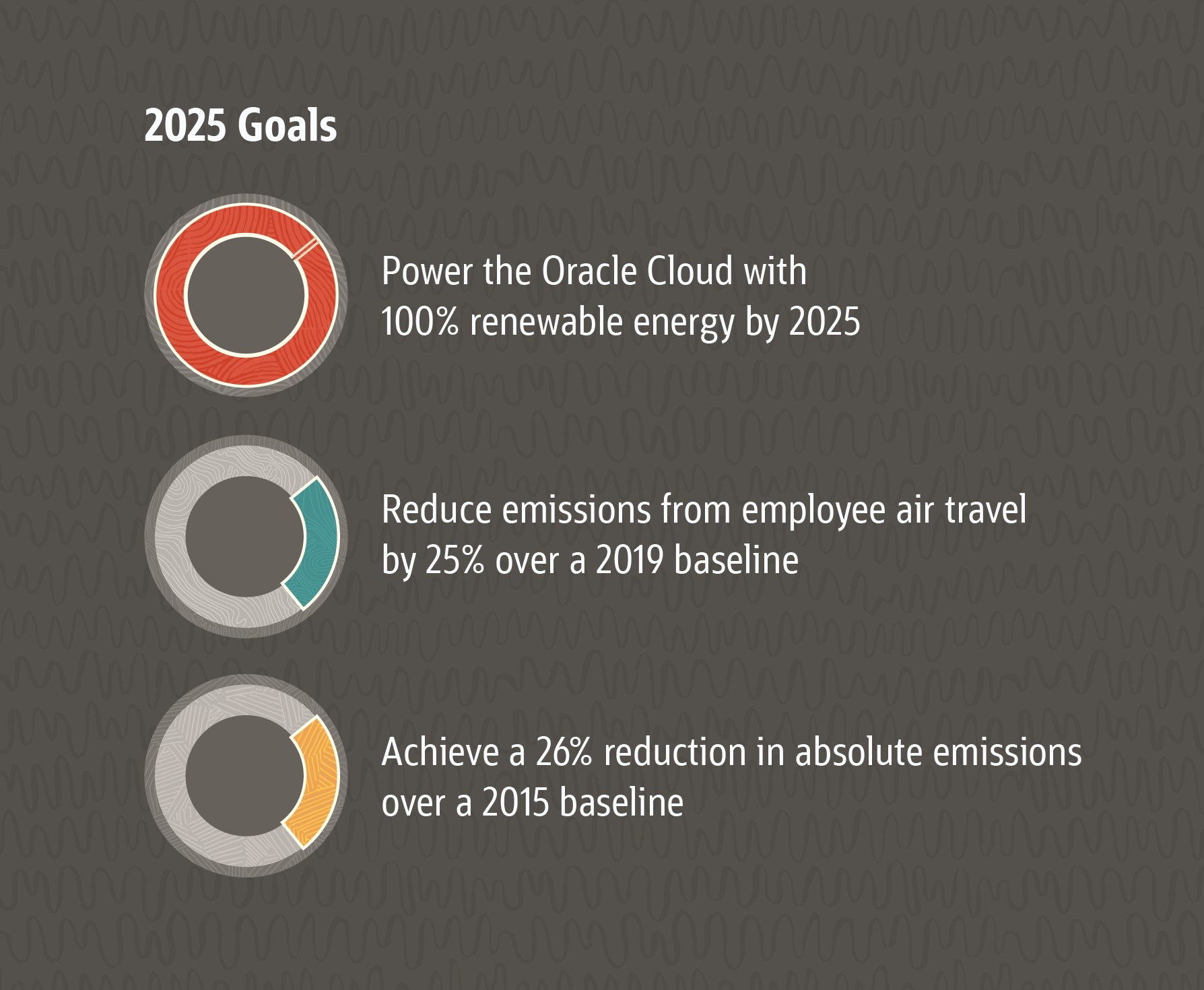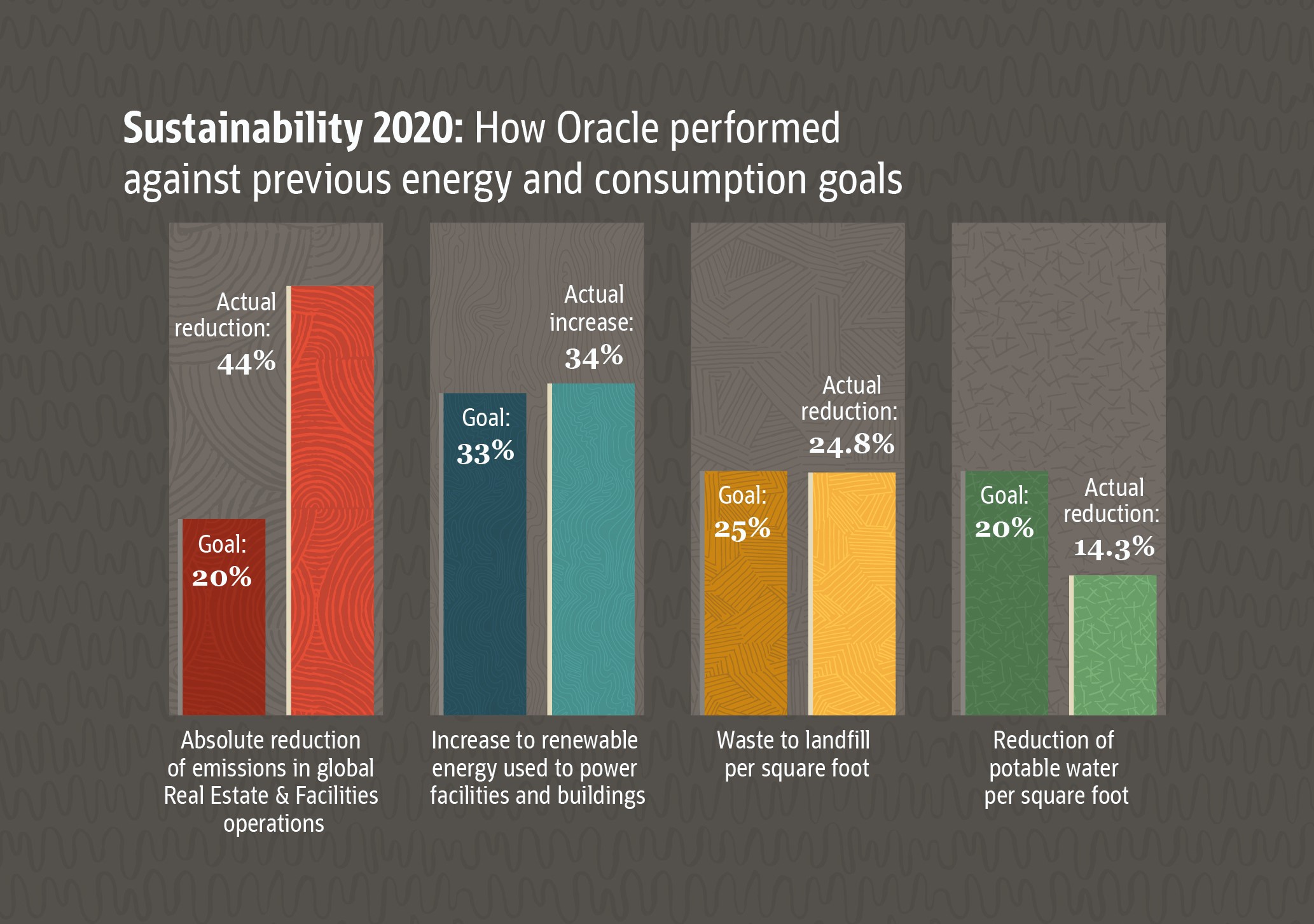In 2015, Oracle set aggressive goals for reducing emissions, waste, and energy and water use at its facilities worldwide, representing more than 25 million square feet of real estate. As 2020 draws to a close, the results of that work are now available and the company is ready to set new sustainability objectives for the next five years.
Oracle’s 2020 goals focused on four key areas: reduce global CO2 emissions, shift to renewable energy sources, divert waste from landfills, and reduce the use of potable water. (See specific percentages below.) Oracle met—or surpassed—those first three goals in 2019, and is on track to achieve the water conservation goal by the end of 2020.
Moving forward, Oracle’s 2025 goals include reducing absolute emissions by 26% compared with a 2015 baseline and reducing emissions per unit of energy consumed by 55%. The company already is making progress: It has cut total emissions by 20.5% and energy emissions intensity by 42.3% (compared with Oracle’s initial 2015 target). These goals follow the Science Based Targets initiative’s (SBTi) guidelines, which set emission levels in accordance with the Paris Agreement on climate change. Oracle is on track to reduce emissions according to the Paris Agreement’s initial 2° warming scenario, but also align with the more recent, revised 1.5° scenario.
Oracle also set goals to reduce its use of potable water per square foot and waste-to-landfill per square foot by 33% by 2025 (over a 2015 baseline).
“We are proud of the success we have already achieved in practice of sustainable business,” says Oracle Chief Sustainability Officer Jon Chorley. “However the Oracle way is that when we achieve one goal we set another more challenging one. Oracle’s new 2025 goals reflect our commitment to sustainability and reflect senior management’s pursuit of continuous improvement in this area of our business.”

Powering Oracle Cloud
Oracle Cloud will play a major part in the company’s continued sustainability improvements. To secure the energy required for its data centers’ ongoing operation, Oracle has set a new goal to power Oracle Cloud with 100% renewable energy by 2025. Oracle data centers worldwide now procure 59% of their energy from renewable sources and have achieved power usage effectiveness (PUE) as low as 1.15 (an ideal PUE is 1.0) thanks to high utilization rates, state-of-the-art energy management, and cooling technologies.
Oracle’s European data centers in London, Amsterdam, Frankfurt, and Zurich already are powered with 100% certified renewable energy. Oracle will apply the lessons learned in those markets to its data centers in other parts of the world.
Streamlining the supply chain
To achieve the objective of creating a more “circular” supply chain, Oracle continues to invest in the Oracle Design for the Environment (DfE) program. Launched in 2017, this initiative applies reverse logistics capabilities to recover, reuse, and remanufacture hardware retired by customers and from Oracle’s cloud data centers. In fiscal year 2020, Oracle collected 2.5 million pounds of retired hardware assets, of which 99.6% was either reused or recycled.
In addition to this recovery effort, Oracle hardware designers work from a set of guidelines to assess a number of product characteristics including energy efficiency, dematerialization, serviceability, and recyclability.
In 2019, Oracle increased the amount of reground plastics it uses for server parts 15-fold and achieved Energy Star certification for its X7-2L and X8-2L series of engineered systems. Oracle also redesigned hardware shipping pallets to allow for double the volume of racks to be shipped in a container, cutting related emissions in half. The company also lightweighted packaging materials and redesigned its packaging solutions to be reused and rotated to reduce packaging waste and natural resources consumption.
Oracle has set 2025 goals to ensure that 100% of its key suppliers—both for direct manufacturing and indirect procurement—have environmental programs in place, and that at least 80% of those suppliers establish emissions-reduction targets by 2025. For the first time, Oracle has set a specific goal to reduce emissions from employee air travel—by 25% by 2025 compared with a 2019 baseline.
To read more about Oracle’s environmental performance, please view the Oracle Corporate Citizenship datasheet.

About the author: Elena Avesani is the global sustainability manager at Oracle, working with a worldwide team of internal and external people to drive Oracle’s sustainability programs and pioneer solutions for global social and environmental challenges.